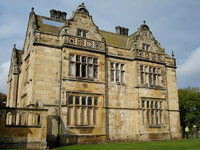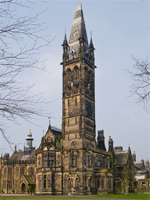Though he his House of polish’t marble built
Yet shall it ruine like the Moth’s fraile cell.*

There is a long tradition of the romanticisation of ruins and decay, but watching once grand houses slide into dereliction is thankfully now seen as a failure; on the part of the owner, and of the official bodies charged with the preservation of our shared architectural heritage. With those local experts disgracefully being seen as expendable by councils, it’s important that English Heritage has produced the 2013 ‘Heritage at Risk Report‘ [PDF] – a sad national roll call from which the priority sites list contains a surprising selection of country houses.
To be included in the list is not to say that a house is derelict, but is more a reflection that there are concerns about the long-term future of the house and current signs of deterioration. Owners can often find that there are significant projects which require substantial investment which may not be currently possible through their own means, though inclusion on the ‘Priority’ list does open doors to grants and other funding.

Perhaps one of the best known to appear is Knebworth House, Hertfordshire, a Victorian fantasy that is now faced with a modern reality. Home to the Lytton family since 1492, the house was originally a mid 16th-century courtyard house before losing three sides in 1811, leaving just the west wing which was remodelled externally in 1820 and 1843 in the Tudor-revival style, with interior alterations by Lutyens in 1907 (see Listing description for details). Still a family home, the Lytton-Cobbolds (as they now are) have worked hard to open the grade-II* house and, famously, host vast pop concerts in the park. Major grant-funded repairs in the late 1990s restored half the house, but now, as a priority case, a further £240,000 has been allocated for works on the roof and to restore the upper rendering and two pinnacles.

For an estate once reputedly tormented by a dragon, the modern threats to Sockburn Hall, Darlington were much more prosaic, but which have meant years of restoration work. The current house was built in 1834 for the younger brother of Sir William Blackett (1758-1816) in whose family it remained until sold in 1920. A varied ownership history led to the period which left it in the current damaged state, when the house was owned by two sisters who were later convicted of keeping many dogs in terrible conditions in Sockburn Hall. The accumulated excrement rotted the floors and a lack of maintenance led to water ingress. New owners and a dedicated team of volunteers have rallied and started restoration, part-funded by English Heritage grants, though work clearly has some way to go before the house will be safe again.

Scraptoft Hall, Leicestershire has long been a cause for concern, faced as it is with threats from the weather, vandals and poor local planning decisions. Originally built in the 1720s, this elegant smaller house, although still on the edge of Leicester, had earlier suffered the usual short-sighted urban development, which now encroaches on it and its condition had deteriorated significantly. However, the setting of the house is still worth preserving, though previous proposals would have unsympathetically left it as a mere architectural bauble in the middle of a much larger development. Sadly, in 2010, despite going against English Heritage advice, the local planning department, council, and MP, were all happy to cast this fine piece of local architectural heritage onto the scrapheap of their own inadequate vision. A reduced scheme was approved in July 2013, which although at a more appropriate scale, still contains some regrettable choices such as separating the house from the lake and ruining the approach to the hall by lining the drive with houses (See Planning Documents: Presentation Layout). This plan will result in the house being restored as eight apartments, but neither the local council or the developer can claim any sort of credit from this outcome.

For anyone stumbling across the Gothic Revival majesty of Scarisbrick Hall, Lancashire, it might seem as thought they had found a university rather than a house – in fact, they had found one of the most remarkable buildings of the Victorian age. On inheriting in 1833, Charles Scarisbrick embarked on a huge project to embellish his home, initially spending £5,500 between 1836-1846 on old antique carvings. As one of the oldest Recusant families, the Scarisbricks had an affinity to the Gothic style and one of the reasons for the Hall’s grade-I listing is the creation in 1812-16 of the first new domestic ‘great hall’, to designs by Thomas Rickman and John Slater. One of the key reason for the highest listing is that the house is one of the greatest surviving examples of the work of A.W.N. Pugin, especially after the ruination of his masterpiece, Alton Towers. Pugin was the architect who thought Gothic was the only ‘true’ architectural path for a Christian nation and, although Charles Scarisbrick initially only asked for a garden seat and a fireplace, Pugin eventually re-designed the interiors before being asked to alter the exterior, creating a more picturesque aspect.

Pugin died in 1852, and Charles Scarisbrick in 1860, after which, Charles’ sister inherited and employed Pugin’s son, Edward Welby, to continue the alterations including the spectacular tower – though without the planned clock so rendering it somewhat pointless. The house passed out of the family in 1872, and was eventually sold for demolition in 1962 but became a school instead, a role it retains today. However, a mounting repair bill (estimated at £2.46m in 2008) has led to the house being added to the ‘at risk’ register, with particular concern about the main hall, and east and west wings. On all counts, this is a remarkable house and warrants close monitoring and support to ensure that this magnificent example of the Gothic Revival doesn’t fall into a more parlous state.
An estate can contain many more buildings than just the main house, such as stables or follies, which form an important part of the a part of the character of an estate, but which can also become at risk. Below are examples from the same priority report:
- Harlaxton Manor, Harlaxton (Registered Park and Garden), South Kesteven, Lincolnshire
- Stowe Landscape Garden (incl. the Palladian Bridge, Temple of Friendship, the East Boycott Pavilion and the Queen’s Temple), Stowe, Buckinghamshire
- St Osyth’s Priory, St Osyth, Tendring, Essex
- The Belvedere, Waldershare Park, Coldred, Dover, Kent
In more positive news, although the grade-I Castle Goring, West Sussex, is included in the list, it also notes that this remarkable house has been sold and work to rectify the maintenance backlog has now started. Congratulations to the South West and West Midlands regions which have no country houses or related buildings included in the 2013 list.
These Registers are a valuable opportunity to highlight the ongoing threats to our shared national architectural heritage, for although many of these country houses and buildings are in private ownership, we all enjoy the wider benefit of their beauty and history. If anyone demands justification as why anyone should care, why we should protect them, just ask them to imagine our country without them.

—————————————————–
Full list (PDF): ‘Heritage at Risk Register – 2013‘ [English Heritage]
Previous blog post: ‘How to get depressed quickly: the English Heritage Buildings at Risk Register 2010‘
—————————————————–
* – Quote by Gaston Boissier, ‘Rome and Pompeii‘ (1896), as quoted in ‘The Pleasure of Ruins‘ by Rose Macaulay

